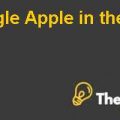TRADER JOE’s CASE STUDY ANALYSIS Case Solution
Challenges Face by Supermarkets:
The traditional supermarkets have to face many challenges due to which they have to operate with a very thin profit margin.
The first challenge they are facing is to provide the product at a price that will accept by the buyer. For this reason, they have to sell their products at discounts, and in addition to this; they also need to adopt several sales promotion activities. They have to achieve high economies of scale to prove them in front of buyers.
The entry barriers are too high, therefore they have to stay put in this competitive industry through continuous struggle. It is also hard to find a supplier who provides them the products at a reasonable margin because the numbers of supermarkets are rapidly growing and the suppliers of the products are not very much increasing in numbers. For this reason, most of the supermarkets try to purchase directly from the manufacturer.
The customers are becoming more sophisticated due to their changing needs and supermarkets have to face the challenge of keeping their research work up to date.
The numbers of players in the markets are increasing year by year and supermarkets are facing the challenge of “hard to find a differentiating strategy” that will make them unique from others.
Technology also plays a pivotal role in the development of supermarkets. As their profits are very thin, so, they need a solution to demonstrate quick payback through increased sales/profit or the cost of operations. The faster checkout systems improved security through the use of CCTV cameras and developing an innovative customer relationship management system will provide up-to-date information about their customer’s needs. The technological changes require huge investment, so, that their system remains up to date and free from the fear of getting obsolete.
This technological improvement will also help them to maintain or increase their return on investment. Currently, these technological changes are available in very future supermarkets.
Financial Analysis
The following table shows various financial ratios for different supermarkets.
| Whole Foods | Kroger | Safeway | Supervalu | |
| Gross Margin % | 35% | 21% | 27% | 22% |
| SG&A as % of Sales | 30% | 19% | 24% | 24% |
| Net Profit Margin | 3% | 1% | 1% | -3% |
| ROE | 11% | 15% | 14% | -4952% |
| Return on Assets | 13% | 5% | 8% | -4% |
| Asset Turns | 2.35 | 3.85 | 2.89 | 3.00 |
| Debt-to-Equity ratio | 43% | 492% | 309% | 57295% |
| Debt-to-Assets ratio | 30% | 83% | 76% | 99.8% |
Whole Foods:
It has very low sales as compared to the other competitors; it can be assumed that this competitor has adopted a focus strategy with the cost focus also. The profit margin of this competitor as compared to the other big competitors is greater, which is 3%. The operational is high as compared to the other competitors which are 30% their return on equity is also low as compared to the others but is at a satisfactory level. However, their ROA shows great results as compared to the others. Their risk level is also low as their debtequity ratio is at an optimal level.
This firm is operating its strategy successfully creating value for shareholders and for the customers also and earning a positive return on their investment.
Kroger:
Kroger’s gross margin as compared to others is low, which is 21%. This is due to the increased manufacturing cost because they may be failing to find a good supplier or maybe they are not using lean management techniques. Their operating cost percentage as compared to the others is low, which indicates that Kroger maybe they are not emphasizing more on their research, advertisement & marketing which may increase their cost but also their revenue.
The debt equity ratio is too high because they are heavily relying on debts as a result; their return on assets is also low, which is 1%. This may find them self-difficult to pay the interest payments in the coming future. They are exposed to greater risk due to the abnormal debt equity ratio. The firm is not operating the way it should despite an increased number of sales, which may be a cost leadership strategy that it is failing to provide value to its shareholders.
Safeway:
Its gross margin as compared to its operating expense margin is quite similar which indicates that despite earning high there operational cost has sunk their profits and reduced their overall effectiveness. The risk is too high as also it also heavily relies on the debts, which results in an increased interest cost and lower down their return on assets. It is utilizing its assets appropriately as their turnover indicates a value of 2.89 however as compared to others like Kroger and Supervalu is low.
They are operating successfully, but the capital structure strategy has restricted their growth.
Supervalu:
This competitor is not operating well by any means. They are highly risky as their debts are showing enormous levels. Their net profit margin due to the greater interest expense is negative. The required rate of return will also be much higher and this also indicates as their ROE is negative that it is not operating as per their adopted generic strategy.
Conclusion:
The analysis of Trader Joe’s competitive position has provided an understanding of the unique advantages Trader Joe’s presently has in a competitive industry. It also highlights the threats that the company is facing. The successful strategy for the supermarket industry is to exactly do what others are not doing. Since the company's starting almost 50 years ago, Trader Joe’s has since then developed a huge following, as they continue to grow and open stores nationwide.
Question 1:
What is your assessment of the current competitive position of Trader Joe’s?
Answer:
Trader Joe's is one of the most successful traders and grocers in the country. The current competitive position of Trader Joe’s is very strong in my opinion, even after the underlying threats to the company. The competitive advantages of Trader Joe’s are strong enough to maintain the company’s position strong in the growing supermarket industry. According to the case study, the company has a unique competitive advantage but there are numerous threats to this advantage.
The aforementioned company has targeted individuals from a higher or educated class. Educated people are usually capable of purchasing items and are not dependent on anyone. So targeting this class was a smart move from the company. This company is known to offer goods and materials that are not available in ay supermarket. Trader Joe’s has a less working investment in the store’s inventory, which proves to be very fruitful for the company. The company only appoints experienced and quality employees to be a part of their team. Quality and unique products at reasonable prices are the unique selling point of Trader Joe’s. The company is also very secretive of their suppliers and the product suppliers' name are kept private.As long as the company stays loyal to its individuality and kept selling items that are not easy to find and takes good care of the needs of its customers, it will continue to be successful and grow.Despite all these competitive advantages the company’s position still seems to be lacking behind.........................
TRADER JOE’s CASE STUDY ANALYSIS Case Solution
This is just a sample partial case solution. Please place the order on the website to order your own originally done case solution.













